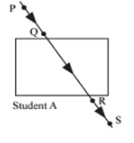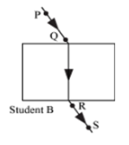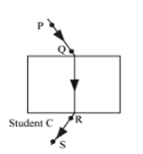 Multiple Choice Questions
Multiple Choice QuestionsA student was given two permanent slides, one of binary fission in amoeba and other of budding in yeast. He was asked to identify any one difference in the nucleus of the two. One such difference, he identified correctly was
Presence of one nucleus in amoeba, two in yeast cell and one in bud.
Presence of two nuclei in centrally constricted amoeba, one in yeast cell and one in its bud.
Presence of two distant nuclei in amoeba, one in yeast cell and two in bud.
Presence of two distant nuclei in amoeba, one in yeast cell and two in bud.
To determine the percentage of water absorbed by raisins, raisins are soaked in water for:
30 seconds
10 minutes
2 to 3 hours
2 to 3 hours
Raisins are wiped off gently before final weighing with help of
a filter paper
a cotton piece
a cloth piece
a cloth piece
The step(s) necessary for determining the percentage of water absorbed by raisins is/are:
Raisins should be completely immersed in water
Raisins should be soaked in water for sufficient time
Gently wipe dry the soaked raisins
Gently wipe dry the soaked raisins
D.
Gently wipe dry the soaked raisins
Rahim recorded the following sets of observations while tracing the path of a ray of light passing through a rectangular glass slab for different angles of incidence.
|
S. No. |
Angle of incidence |
Angle of refraction |
Angle of emergence |
|
The correct observations are recorded at a serial number:
|
I |
45o |
41o |
45o |
|
|
II |
40o |
38o |
38o |
|
|
III |
45o |
41o |
40o |
|
|
III |
45o |
41o |
40o |
|
Four students A, B, C and D traced the paths of incident ray and the emergent ray by fixing pins P and Q for incident ray and pins R and S for emergent ray for a ray of light passing through a glass slab.
The correct emergent ray was traced by the student:




Mohan obtained a sharp inverted image of a distant tree on the screen placed behind the lens. He then moved the screen and tried to look through the lens in the direction of the object. He would see:
a blurred image on the wall of the laboratory.
an erect image of the tree on the lens.
no image as the screen has been removed
no image as the screen has been removed
For finding the focal length of a convex lens by obtaining the image of a distant object, one should use as the object.
A well-lit distant tree
Window grill in the class room
Any distant tree
Any distant tree
To find the focal length of a concave mirror Rahul focuses a distant object with this mirror. The chosen object should be
A tree
A building
A window
A window
